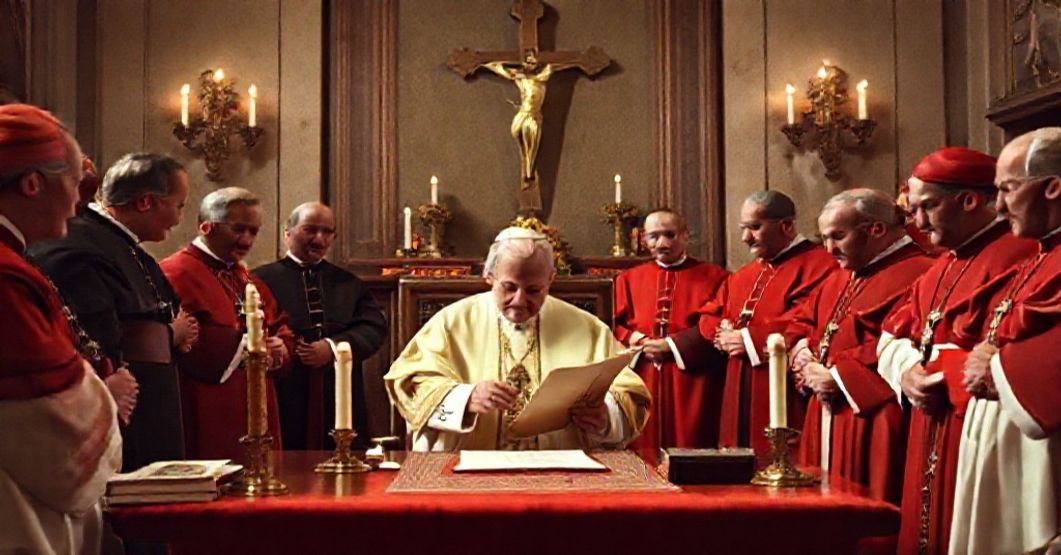Antipopes of the Antichurch



















Timeline of this heretical pontiff
Encyclical Letters
+ 15 posts1959
+ 7 posts1961
+ 4 posts1962
+ 2 posts1963
+ 2 postsApostolic Exhortations
+ 3 postsApostolic Constitutions
+ 93 posts1958
+ 6 posts1959
+ 87 postsMotu Proprio
+ 15 posts1958
+ 1 posts1959
+ 1 posts1962
+ 11 postsApostolic Letters
+ 151 posts1958
+ 4 posts1959
+ 63 posts1960
+ 78 posts1961
+ 1 posts1962
+ 4 posts1963
+ 1 postsSpeeches
+ 99 posts1958
+ 2 posts1959
+ 26 posts1960
+ 29 posts1961
+ 16 posts1962
+ 24 postsMessages
+ 6 posts1959
+ 4 postsHomilies
+ 4 postsLetters
+ 152 posts1958
+ 1 posts1959
+ 48 posts1960
+ 32 posts1961
+ 31 posts1962
+ 30 posts1963
+ 10 postsNot categorized
+ 1 posts1958
+ 1 postsNews feed


AD SUBURBICARIAS DIOECESES IUS OPTIONIS (1961.03.10)
The text issued under the name of John XXIII on 10 March 1961, presented as a motu proprio, announces the abolition of the canonical “right of option” for suburbicarian sees and reserves to himself and his successors the free appointment of cardinal-bishops to those dioceses, invoking demographic and pastoral changes as a pretext for centralizing control within the already deformed conciliar structure. In one seemingly technical gesture of juridical micromanagement, the antipope exposes the underlying project: to re-engineer the visible structures inherited from the Church while emptying them of their Catholic substance, bending episcopal office and ancient order to the will of a revolutionary regime.


Consilium datae (1962.02.02)
This short Latin text, issued by John XXIII on 2 February 1962, fixes 11 October 1962 as the opening date of the so‑called Second Vatican Council, invokes the memory of Ephesus, exhorts worldwide prayer for the event, and presents the future council as a means for the Church to radiate its divinely given strength more widely and to promote peace among nations. In reality, this motu proprio is the juridical spark that lights the conflagration of conciliar revolution, preparing the stage for an institution that dares to refashion doctrine, worship, and discipline against the perennial Magisterium of the Church of Christ.


Suburbicarian Sees As Mirrors Of The Conciliar Power Usurpation
The text issued under the name of Ioannes XXIII on 11 April 1962, a Motu Proprio concerning the “regimen of the suburbicarian dioceses,” reorganizes the relationship between the historic suburbicarian sees and those bearing the red hat: it transforms Cardinal-Bishops into merely titular holders of suburbicarian churches without real jurisdiction, centralizes in the antipope the free appointment of such titles, assigns actual ordinary power to separate residential bishops, and integrates these ancient sees structurally into a “conference” with the Roman diocese, all under the sign of administrative optimization and curial efficiency. In one stroke, the historic nexus between the episcopal dignity, real pastoral jurisdiction, and the highest rank of the Roman clergy is stripped and replaced by a functionalized, bureaucratic, jurisdictionless aristocracy at the service of a new power structure—an act that manifests not pastoral care, but the progressive demolition of the visible constitution of the Church in favor of the conciliar sect’s paramasonic regime.


Cum gravissima (1962.04.15)
The document “Cum gravissima” (15 April 1962), issued Motu proprio by John XXIII, decrees that all members of the College of Cardinals are henceforth to be endowed with episcopal dignity; it confirms the threefold internal division (episcopal, presbyteral, diaconal) as merely honorific and juridical while granting all Cardinals the fullness of the priesthood, and it adjusts canon law so that Cardinal Deacons may pontificate in their diaconal churches similarly to Cardinal Priests in their titles. In the self-congratulatory rhetoric of institutional efficiency and universal representation, this text calmly instrumentalizes the episcopate, desacralizes hierarchical order, and prepares a bureaucratic oligarchy as the governing core of the conciliar revolution.
Varia
Announcement:
– News feed –implemented
– Antipopes separate web sites with their all documents refutation – in progress
